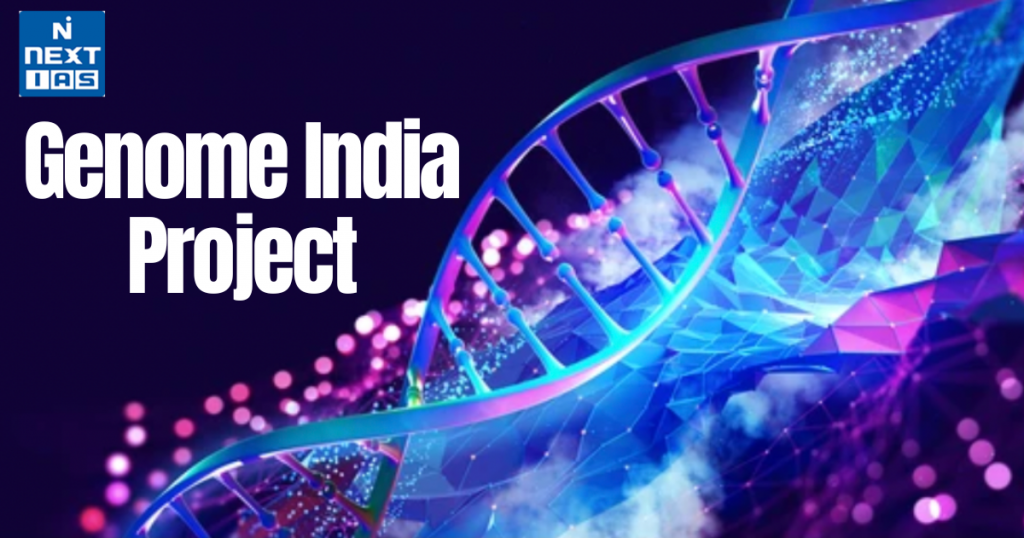
The Genome India Project (GIP) is a scientific initiative launched in 2020 to sequence the genomes of diverse Indian populations and understand genetic variations and disease-causing mutations. Its significance lies in its potential to advance personalized medicine and improve healthcare outcomes tailored to the unique genetic makeup of the Indian population. This article aims to study in detail the objectives, significance, challenges, and potential impact of the Genome India Project on health and science in India.
About Genome India Project (GIP)
- It is a scientific initiative inspired by the Human Genome Project (HGP), an international effort that successfully decoded the entire human genome between 1990 and 2003.
- The project was started in 2020, aiming to understand better the genetic variations and disease-causing mutations specific to the Indian population, one of the most genetically diverse in the world.
- By sequencing and analyzing these genomes, researchers hope to gain insights into the underlying genetic causes of diseases and develop more effective personalised therapies for the Indian Population.
- The project involves the collaboration of 20 institutions across India. It is being led by the Centre for Brain Research at the Indian Institute of Science in Bangalore.
Need of Genome India Project
- India’s population of 1.3 billion comprises over 4,600 diverse population groups, many of which are endogamous (Marriages in Close circles or populations).
- These groups have unique genetic variations and disease-causing mutations which cannot be compared to other populations.
- Unique genetic variants are present in India due to interbreeding. Hence mapping them and using that information to create personalised drugs and therapies can be possible.
- The United Kingdom, China, and the United States are among the countries that have programmes to sequence at least 1,00,000 of their genomes.
Significance of Genome India Project (GIP)
- Precision Healthcare:
- It aims to develop personalised medicine based on patients› genomes to anticipate and modulate diseases.
- By mapping disease propensities to genetic variations, interventions can be targeted more effectively, and diseases can be anticipated before they develop.
- For example, variations across genomes may explain why cardiovascular disease leads to heart attacks in South Asians but to strokes in most parts of Africa.
- Sustainable Agriculture:
- Similar benefits will come to agriculture if there is a better understanding of the genetic basis of plants’ susceptibility to pests, insects, and other issues hampering productivity.
- This can reduce dependence on chemicals.
- International Cooperation:
- Global science will also benefit from a mapping project in one of the world’s most diverse gene pools.
- The project is said to be among the most significant of its kind in the world because of its scale and the diversity it would bring to genetic studies.
Challenges of Genome India Project (GIP)
- Scientific Racism:
- This raises concerns about the potential for scientific racism and the reinforcement of stereotypes based on heredity and racial purity. Similar scientific studies in the past have been used to justify slavery and other forms of discrimination by using theories like white man’s burden.
- Genetic mapping may further deepen these divisions in a country like India, which is already divided by identity politics.
- Data Privacy:
- The project also raises questions about data privacy and storage. Without a comprehensive data privacy bill in India, concerns about the possible misuse of genetic information collected by the GIP cannot be overlooked.
- Ethical Concerns:
- It raises ethical questions about the potential for doctors to privately perform gene modification or selective breeding.
- Such practices have always been controversial; in 2020, a scientist in China who created the world’s first gene-edited babies was sentenced, highlighting the seriousness. Such instances should always be considered before allowing such projects.
| What is a Genome? – The discovery of the DNA structure by Watson and Crick in 1953 marked the beginning of the study of genetics, which seeks to understand how genes influence traits and diseases. – DNA, or Deoxyribonucleic acid, is a molecule that carries the genetic instructions for the development, functioning, growth, and reproduction of all living organisms. – The genome of an organism is the complete set of its genetic material, including all of its genes. It contains all the information required to build and maintain the organism. |
| – In humans, the genome comprises more than 3 billion DNA base pairs arranged in a double helix structure. – The study of genomics, which involves the analysis of genomes, has revolutionised many fields, including biotechnology, medicine, and agriculture, by providing new insights into the mechanisms of disease, drug development, and improving crops and livestock. What is Genome Sequencing? – Genome sequencing is figuring out the order of DNA nucleotides, or bases, in a genome—the order of adenine (A), thymine (T), cytosine (C), and guanine (G), that make up an organism’s DNA. |
Conclusion
In conclusion, the Genome India Project represents a critical step toward understanding the genetic underpinnings of health and disease in one of the world’s most genetically diverse nations. By mapping the genomes of various population groups, the project holds the potential to enhance personalized medicine, improve agricultural resilience, and contribute to global genetic research. However, it is essential to navigate the ethical and privacy challenges that accompany such groundbreaking scientific endeavors. As the GIP progresses, its success could set a precedent for future genomic research and applications in India and beyond, ultimately leading to improved health outcomes and a deeper understanding of human genetics.
FAQs
Who launched the genome India project?
The Genome India Project was launched by the Department of Biotechnology (DBT), Government of India. Led by the Indian Institute of Science (IISc), Bengaluru, in collaboration with a consortium of research institutions, it aims to map India’s genetic diversity for advancements in healthcare, precision medicine, and disease prevention.
What are the aims of genome India project?
The Genome India Project aims to map genetic diversity across India’s population, enabling advancements in personalized medicine, disease prevention, and genetic research. It seeks to identify population-specific health risks, improve drug responses, and contribute to global genomic studies, fostering precision healthcare and biotechnological innovation in India.
What is the indigen genome project?
The IndiGen Genome Project, launched by the Council of Scientific and Industrial Research (CSIR), India, aims to sequence and analyze Indian genomes to understand genetic diversity. It helps in developing personalized medicine, identifying disease risks, and improving healthcare by creating a comprehensive genetic database for India’s population.
Which is the nodal agency for genome India project?
The Indian Institute of Science (IISc), Bengaluru, is the nodal agency for the Genome India Project, launched by the Department of Biotechnology (DBT), Government of India. IISc leads a consortium of 20+ research institutions to map India’s genetic diversity, advancing precision medicine and healthcare innovation.
What is the Genome India project, why it matters?
The Genome India Project is a national initiative to map India’s genetic diversity by sequencing 10,000 Indian genomes. It matters because it enables precision medicine, disease risk assessment, and genetic research, helping develop targeted therapies, improve healthcare, and contribute to global genomic studies, fostering medical and biotechnological advancements in India.






